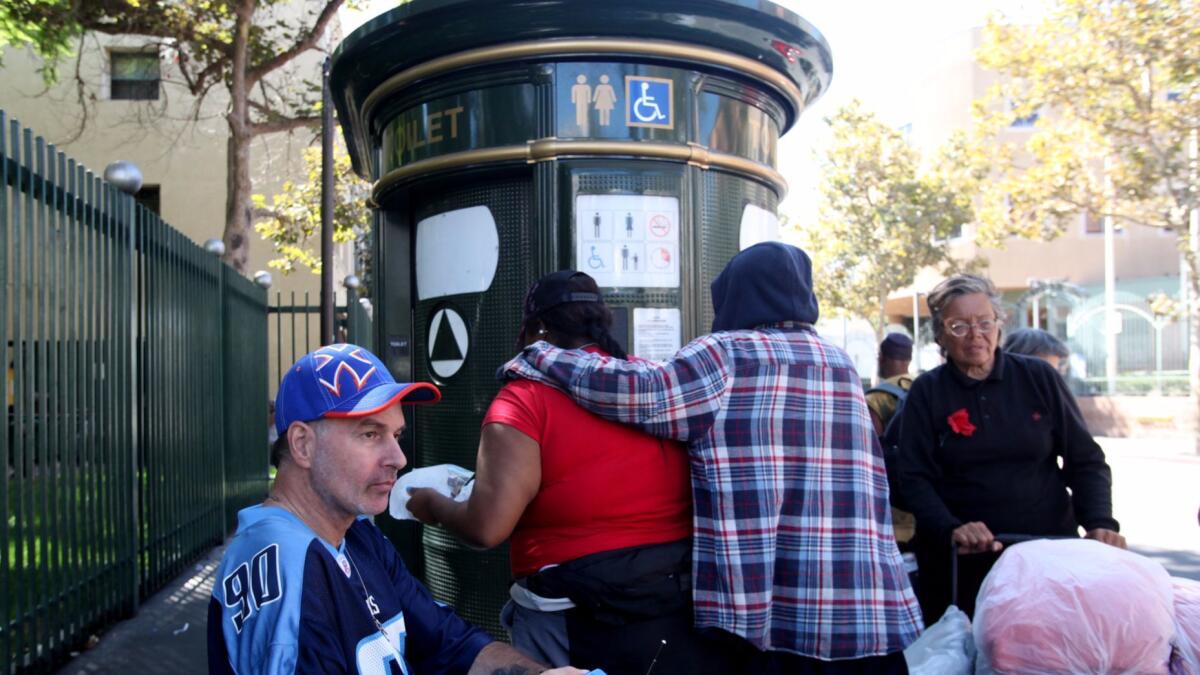Bathroom access on skid row is worse than in a Syrian refugee camp, report says

Homeless people on skid row have less access to bathrooms than Syrian refugees living in a United Nations camp overseas, according to a report released Thursday by a group of homeless service providers, advocates and residents.
The report found only nine public toilets open at night for 1,800 homeless people sleeping on skid row sidewalks and alleys. The conditions violate sanitation standards that the United Nations High Commissioner for Refugees sets for long-term camps, including a Jordan installation for Syrian refugees, the report said.
During the day, more bathrooms are open, but the facilities still fall short of U.N. minimum standards by 64 toilets, the study found.
The bathroom crunch has persisted despite 2012 findings by the Los Angeles County Department of Public Health that human waste, extreme overcrowding and exposed living conditions in the 50-block skid row district posed an increased risk of meningitis, staph, lice and fungal infections, along with hepatitis A.
The health department recommended that the city add toilets and access to soap, water and hand sinks, but skid row is still waiting, the report said.
“The lack of basic amenities like public toilets has gone on for so long that in skid row, the absurd has become the normal,” the report said.
“This is a public health crisis,” said Homeless Health Care Los Angeles Administrator Stephany Campos, who participated in the audit.
A spokesman for Mayor Eric Garcetti said he had earmarked $1.3 million in his 2017-18 budget for mobile showers and bathrooms, and the Department of Recreation and Parks is building two permanent restrooms in San Julian and Gladys parks on skid row.
“Everyone should be able to bathe or use the restroom safely and with dignity, and anyone who walks the streets of skid row knows that we need infrastructure that meets the needs of our unsheltered population,” Garcetti press secretary Alex Comisar said in an email.
The report, titled “No Place to Go,” calls for the city to provide 107 additional toilets by the end of the year. It was based on an audit in January and February conducted by the Los Angeles Central Providers Collaborative, the city-county C3 homeless outreach team, Los Angeles Mission, Midnight Mission, Downtown Women’s Center, the Inner City Law Center and skid row residents and organizations.
The audit found that 38% of the available bathrooms were broken during operating hours, and most lacked soap, paper towels and menstrual products. Homeless people have to ask guards to use mission facilities, and staff are stingy with toilet paper, the report said.
The bathrooms are also hard to get into, inaccessible to disabled people and provide no privacy, the auditors said.
“Users have to step over people sleeping in a crowded courtyard to get to the toilets and once inside, users discover that the stalls have no doors,” the report said.
Photographer Alexander Laurent, a former skid row apartment resident, said the sanitation problems affect not just homeless people but those who live in the 50-block downtown district’s buildings.
“The overwhelming environment, the smell, the unsanitary conditions definitely take a toll on you just as an observer,” said Laurent, who helped with the audit. “How are these conditions acceptable?”
The report called on the city to hire and train bathroom attendants selected from the skid row community to provide round-the-clock security and referrals to food, shelter, showers, clothes washers and healthcare. The attendants could be equipped with cellphones to report safety concerns or alert maintenance crews when repairs or supplies are needed, the report said.
“This collaboration must dedicate additional public resources to provide sufficient ... toilets that are functional and architecturally pleasing,” the report said. “The community will be better able to thrive when its members feel safe and comfortable and the community is cleaner, safer, more environmentally friendly and attractive.”
Twitter: @geholland
ALSO
Homeless cleanups in L.A. have surged, costing millions. What has been gained?
L.A. Trade-Tech algebra innovations spark uproar — and an internal investigation
The purple behemoth that was a Koreans-only hostess joint wants to be an arts hub for all
San Francisco to pay $190,000 for sanctuary law violation, lawyer says
More to Read
Sign up for Essential California
The most important California stories and recommendations in your inbox every morning.
You may occasionally receive promotional content from the Los Angeles Times.


![Los Angeles, CA - May 19: Carlos Vargas, left, and Paulina Rubio, members of the harm reduction team from Homeless Outreach Program Integrated Care Systems [HOPICS], a leading homeless services and housing agency, look for drug addicts to help and pass out supplies at a homeless RV encampment along 77th St. in South Los Angeles Friday, May 19, 2023. The team hands out syringes, fentanyl test strips, overdose reversal nose spray and medication to prevent overdoses, infection and disease transmission, including the HIV virus. Fenanyl is particularly insidious because it can be found in all other drugs, especially meth and heroin. The handouts are also meant to reduce infection through broken pipes, which can cut users mouths and open them to infection. . (Allen J. Schaben / Los Angeles Times)](https://ca-times.brightspotcdn.com/dims4/default/530e2db/2147483647/strip/true/crop/3900x2608+0+34/resize/320x214!/quality/75/?url=https%3A%2F%2Fcalifornia-times-brightspot.s3.amazonaws.com%2Fe9%2F77%2F4b8bd35d4881a3edec6b945b143b%2F1298639-me-soaring-fentanyl-deaths-24-1-ajs.jpg)








